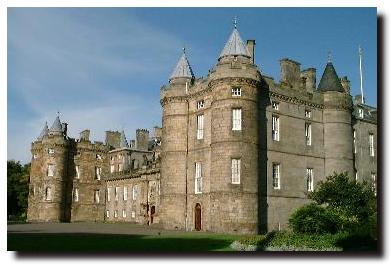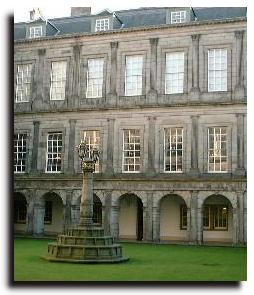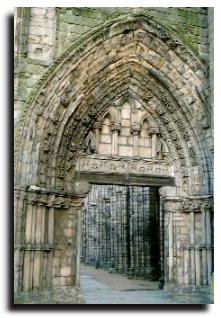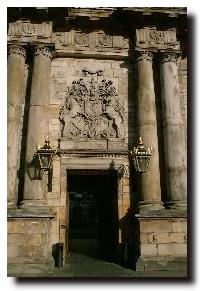 According to legend, King David II founded an Augustinian monastery where he had a vision of a stag with a cross between its antlers. This was about a mile to the east of Edinburgh Castle (and the road linking the two buildings is still called the Royal Mile). The monastery may have taken its name from a fragment said to have come from the true cross brought to Scotland by the king's mother, Queen (later Saint) Margaret.
According to legend, King David II founded an Augustinian monastery where he had a vision of a stag with a cross between its antlers. This was about a mile to the east of Edinburgh Castle (and the road linking the two buildings is still called the Royal Mile). The monastery may have taken its name from a fragment said to have come from the true cross brought to Scotland by the king's mother, Queen (later Saint) Margaret.
Many of the succeeding Scottish kings preferred staying beside the monastery rather than the castle and gradually a the Palace was enlarged. King James IV and James V in particular, added considerably to the structure and much of what they created has survived. King James IV was married in the Abbey to Margaret Tudor.
Mary Queen of Scots was involved in many dramatic events in the Palace, including her marriage to Lord Darnley and the murder of her Italian secretary, Rizzio. She later married the Earl of Bothwell in Holyroodhouse after Darnley had been murdered.
 The Palace was little used after King James VI became King of England as well as Scotland and moved to London. But it was renovated for his return visit in 1617 and in 1633 for the coronation of his son, Charles I. The Palace was damaged by Cromwellian forces during the Civil War but, on his return to the throne, King Charles II ensured that it was restored and extended (though he never returned to Scotland).
The Palace was little used after King James VI became King of England as well as Scotland and moved to London. But it was renovated for his return visit in 1617 and in 1633 for the coronation of his son, Charles I. The Palace was damaged by Cromwellian forces during the Civil War but, on his return to the throne, King Charles II ensured that it was restored and extended (though he never returned to Scotland).
 The Catholic King James VII set about making the Abbey suitable for Catholic ritual and the ceremonies of the ancient Order of the Thistle. A Jesuit college was also established in the precincts. When King James VII was forced to flee by the arrival of his Protestant daughter Mary and her husband, William of Orange, the Abbey became a target for a rioting mob and was badly damaged. But it was the collapse of the roof in 1768 (which was never repaired) which did most damage to the Abbey.
The Catholic King James VII set about making the Abbey suitable for Catholic ritual and the ceremonies of the ancient Order of the Thistle. A Jesuit college was also established in the precincts. When King James VII was forced to flee by the arrival of his Protestant daughter Mary and her husband, William of Orange, the Abbey became a target for a rioting mob and was badly damaged. But it was the collapse of the roof in 1768 (which was never repaired) which did most damage to the Abbey.
In 1745, Bonnie Prince Charlie held court at Holyroodhouse and it was later used intermittently by guests of the monarch. The Palace was spruced up in 1822 for the visit of King George IV to Scotland. After this, more renovation and alterations were made - but the king commanded that Mary Queen of Scots apartments should be preserved from alteration. But it was Queen Victoria, who found Holyroodhouse a welcome stopover on the journey to Balmoral and who reinstated it as the prime royal residence in Scotland.
 Visitors to the Palace arrive first at the great stair at the entrance which is hung with magnificent tapestries. They then move on to the royal dining room which is, surprisingly, adorned with pictures of Bonnie Prince Charlie. The Throne Room was used by King George IV when he was presented with the crown of Scotland. Other apartments are sumptuously furnished and there are internal fretwork ceilings created by English plasterers and paneling by Dutch craftsmen. Perhaps the most impressive room is the Great Gallery. It contains 110 portraits of real and imaginary kings of Scotland, from Fergus I to Charles II, painted (mass produced, might be a better term) by Jacob de Wet the Younger in 1684.
Visitors to the Palace arrive first at the great stair at the entrance which is hung with magnificent tapestries. They then move on to the royal dining room which is, surprisingly, adorned with pictures of Bonnie Prince Charlie. The Throne Room was used by King George IV when he was presented with the crown of Scotland. Other apartments are sumptuously furnished and there are internal fretwork ceilings created by English plasterers and paneling by Dutch craftsmen. Perhaps the most impressive room is the Great Gallery. It contains 110 portraits of real and imaginary kings of Scotland, from Fergus I to Charles II, painted (mass produced, might be a better term) by Jacob de Wet the Younger in 1684.
The apartments of Mary Queen of Scots are on a much less grand scale but articles belonging to the tragic Queen provide a poignant reminder of her.
Photography is not permitted inside the Palace but is allowed outside in the grounds and in the ruined abbey. But it is only those invited to the Royal Garden parties held each summer in the gardens to the rear of the Palace, who get to photograph there. The Queen spends some time in Holyroodhouse each year and entertains foreign dignitaries there. The European Summit Conference of heads of state was held there in December 1992.



